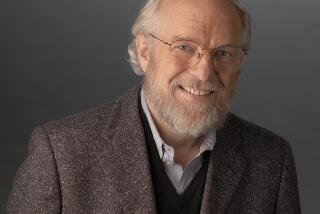Microchip Inventor Has Graphic Vision for Computers : Technology: The future lies in affordable, three-dimensional displays, he predicts.
- Share via
ANAHEIM — For inventor Gilbert P. Hyatt, the future of personal computer technology lies in computer graphics.
Hyatt, who was awarded a patent in 1990, decades after he invented the first microprocessor--or computer on a chip--in the 1960s, said he is now working to improve computer graphics and display technology to make computers easier and more compelling to use.
Hyatt found a receptive audience Monday at the National Computer Graphics Assn. convention, where 150 companies are displaying the latest technology to more than 30,000 computer enthusiasts at the Anaheim Convention Center through Thursday.
“We need to capture something on screen that stimulates rather than offends human vision and makes computers easier to understand,” Hyatt said. “Progress in the future is not in making faster microprocessors. Three-dimensional display technology is where the revolutionary advances will be, and this kind of system will be affordable by the end of the century.”
Of course, right now, the latest in computer graphics technology--costing hundreds of thousands of dollars--is affordable only to those with deep pockets.
But exhibitors at the show are displaying applications where the industry has made dramatic progress: computer animation in films, multimedia presentations for corporate meetings, engineering and photography.
American Video Communications Inc., a Los Alamitos firm that makes and sells large-screen television displays, was showing off a new $250,000 display system that could spread an image across multiple 67-inch television screens.
The system, which links as many as 24 screens together side-by-side as a single mammoth screen, is meant to present graphic data to a large number of people in a command center, said Larry Pell, American Video president.
Pell showed one application designed to help a municipal fire department identify the location of a fire, the presence of hazardous chemicals and nearby fire hydrants. With a click of a computer mouse pointing device, the huge display screen zooms in on the correct data within seconds for all in the control room to see.
Xaos Inc., a San Francisco computer animation company, displayed several animated sequences it created for the film “The Lawnmower Man,” which opened in Southern California last weekend.
Helene Plotkin, executive producer at Xaos, said the company used advanced computer workstations to create seven minutes of animation sequences for the movie, which is based on a Stephen King short story about a man whose intelligence increases vastly when he is introduced to a computer-animated, three-dimensional world inside a computer.
In one scene, a bad guy “particulates.” To show this, Xaos took footage of an actor and used its computer workstations to tear him apart into little bubbles that dissipated the image of the man and then reconstructed him.
“Computer graphics came of age in the movies with ‘Terminator 2: Judgment Day,’ ” said Joseph Lewis, an animator at General Lift Corp. in Venice. “It is becoming more affordable.”
Lewis said his computer animation firm just spent 3,000 hours creating special effects for “Interceptor,” a film that includes stealth bomber aircraft sequences.
Eastman Kodak Co. displayed its digital cameras, which capture images on computer disks rather than photographic film. Keith Watanabe, a Kodak sales representative, said the cameras cost about $20,000 and cannot duplicate the highest quality film cameras yet, but he said they can instantly reproduce photos on a computer screen without the need for film development.






